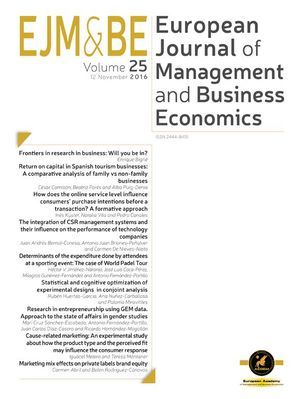European Journal of Management & Business Economics is a great window for drawing researchers’ attention to topics of interest. New topics are being published everywhere, stimulating new directions and straightforward insights. Human resources are not new in management, but reflect a valuable asset to company's performance. This new issue is addressing some academic and practical topics of interest on human resources.
The opening paper by Leticia Pérez-Calero and Carmen Barroso deals with the effect of the type of board members on firm performance. The research question of this paper is whether board members who serve on multiple boards (interlocks) can affect a firm's profitability. Using data from a four-year period, and a generalized method of moments (GMM), the paper confirms that an inverted-U relation between interlocks and firm performance is only significant when the total number of interlocks is included rather than the number of ties belonging only to the non-executive directors. Second, the moderating effect of board tenure on the negative relation between a high total number of interlocks and firm performance is confirmed.
The second paper deals with human resources management. This interesting research done by Antonio Aragón, Gregorio Sánchez and Arlee Mueses examines strategic human resource practices as a catalytic mechanism influencing the effectiveness of knowledge management. Their findings confirm that knowledge management strategies positively influence firm performance through certain high work performance practices – selective staffing, intensive training, active participation, comprehensive performance appraisal, and performance-based compensation – highlighting the mediating role of human resource management.
Francisco García-Lillo, Mercedes Úbeda-García and Bartolomé Marco-Lajara present the paper titled The Intellectual Structure of Human Resource Management Research: A Bibliometric Study of the Journal The International Journal of Human Resource Management, 2000–2012. The paper identifies the main research streams within the human resource management and also provides useful insights through Social Networks Analysis
Family firms are somehow related to human resources since shareholders can be considered as a part of the human resources in family firms. Alejandro Hernández and Carmen Galve show in their paper the existence of a nonlinear U-shaped relationship between the level of diversification (total and unrelated) and the ownership concentration in family group, thus confirming a different behavior depending on the capital held by the main shareholders.
The last paper, by M. Reyes González, José Luis Gascó and Juan Llopis, examines information systems outsourcing. This paper explores extensively the reasons that lead companies to outsource and what the major risks are inherent in this practice. A three-year period of analysis confirms that strategic reasons are more salient, followed by technological and economic reasons.
I hope you will enjoy this new issue of the European Journal of Management & Business Economics.




